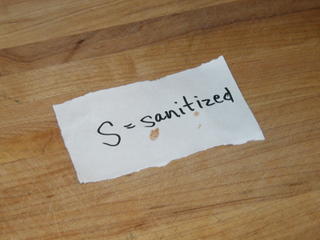Both solutions are changed three to four times each day as it's solied. A new solution is made until the end of the day. Fresh towels are placed in each solution. The sanitizer solution is made from quaternary ammonia. "Quat" can be purchased at restaurant supply houses in a one-gallon bottle.
To test solution strength (at 200 parts per million), dip the quat test strip into the solution for 10 seconds. Remove the test strip and compare it to that color chart on dispenser. If you measured correctly, the color will match the color for 200 ppm (olive green on my test strips). Add additional quat to the solution if it reads less than 200 ppm.
Most manufactures instruct you to use 1-ounce for 4 gallons water. However, always follow the instructions on the product label. Test solution after mixing and record the strength (in ppm) on the food safety log. Never increase sanitizer concentration levels above manufacturer’s recommendations due to potential safety hazards to employees.
To use the sanitizing solution, ring the towel dry and wipe the solution on all clean food contact surfaces in the kitchen. A food contact surface is any surface the contacts food in the kitchen. It includes work tables, cutting boards, can openers, serving lines, mixer, meat slicer, etc. When possible, run pots, pans, utensils, etc., through the dishmachine to sanitize. The ladies started marking sanitized surfaces with "S equals sanitized" tags this year.
The ladies started marking sanitized surfaces with "S equals sanitized" tags this year.


No comments:
Post a Comment